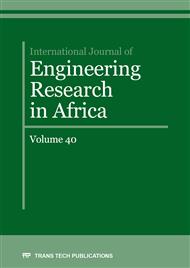[1]
A.A. Raheem, and M.A. Kareem, Chemical composition and physical characteristics of rice husk ash blended cement, International Journal of Engineering Research in Africa, 32(2017) 25-35.
DOI: 10.4028/www.scientific.net/jera.32.25
Google Scholar
[2]
W.H.J. Tchamdjou, S. Grigoletto, F. Michel, L. Courard, M.L. Abidi and T. Cherradi, An investigation on the use of coarse volcanic scoria as sand on portland cement mortar, Case Studies in Construction Materials, 7(2017) 191–206. https://doi.org/10.1016/j.cscm.2017.07.005.
DOI: 10.1016/j.cscm.2017.07.005
Google Scholar
[3]
W.H. Juimo T., S. Grigoletto, F. Michel, L. Courard, T. Cherradi and M.L. Abidi, Effects of various amounts of natural pozzolans from volcanic scoria on performance of portland cement mortars, International Journal of Engineering Research in Africa, 32(2017) 36-52. https://doi.org/10.4028/www.scientific.net/JERA.32.36.
DOI: 10.4028/www.scientific.net/jera.32.36
Google Scholar
[4]
F. Puertas, I. Garcia-Diaz, A. Barba, M.F. Gazulla, M. Palacios, M.P. Gomez, and S. Martinez-Ramirez, Ceramic wastes as alternative raw materials for Portland cement clinker production, Cement & Concrete Composites, 30(2008) 798–805.
DOI: 10.1016/j.cemconcomp.2008.06.003
Google Scholar
[5]
Y. Senhadji, G. Escadeillas, M. Mouli, H. Khelafi, and Benosman, Influence of natural pozzolan, silica fume and limestone fine on strength, acid resistance and microstructure of mortar, Powder Technology, 254(2014) 314–323.
DOI: 10.1016/j.powtec.2014.01.046
Google Scholar
[6]
EN 196-1, Methods of testing cement. Part 1: Determination of strength, (2005).
Google Scholar
[7]
M. Drechsler and A. Graham, Innovative material technologies: bringing resources sustainability to construction and mining industries. In: 48th institute of quarrying conference, Adelide SA, Australia, (2005).
Google Scholar
[8]
A.T. Jakubick, G. McKenna, and A.M. Robertson, Stabilisation of tailings deposits, International experience in proceedings of mining and the environment III, Canada, 2003, p.25–28.
Google Scholar
[9]
P. Kinnunen, A. Ismailov, S. Solismaa, H. Sreenivasan, M.-L. Räisänen, E. Levänen, and M. Illikainen, Recycling mine tailings in chemically bonded ceramics - A review, Journal of Cleaner Production, 174(2018) 634-649.
DOI: 10.1016/j.jclepro.2017.10.280
Google Scholar
[10]
H. Akbulut, G. Cahit, C. Sedat, and E. Ayfer, Investigation of using granite sludge as filler in bituminous hot mixtures, Construction and Building Materials, 25(2011) 3773–3781.
DOI: 10.1016/j.conbuildmat.2012.04.069
Google Scholar
[11]
EN 196-6, Methods of testing cement-part 6: determination of fineness, (2010).
Google Scholar
[12]
EN 196-2, Method of testing cement. Part 2: Chemical analysis of cement, (2006).
Google Scholar
[13]
A. Bouyahyaoui, T. Cherradi, M.L. Abidi, W.H.J. Tchamdjou, Characterization of particle shape and surface properties of powders from volcanic scoria, Journal of Materials and Environmental Science, 9(7)(2018) 2032-2041. http://www.jmaterenvironsci.com/Document/vol9/vol9_N7/224-JMES-3858-Bouyahyaoui.pdf.
DOI: 10.5220/0010430901590171
Google Scholar
[14]
EN 197-1, Composition, specifications and conformity for common cements, Part 1, (2000).
Google Scholar
[15]
E. Halleux, Valorisation des cendres de balles de riz pour la production de matériaux pouzzolaniques à Madagascar, Travail de fin d'études réalisé en vue de l'obtention du grade de Master Ingénieur Civil des Constructions. Université de Liège. 111p, (2013).
DOI: 10.3406/jobot.1998.1707
Google Scholar
[16]
EN 1015-3, Methods of test for mortar for masonry – Part 3: Determination of consistence of fresh mortar (by flow table), (1999).
DOI: 10.3403/01541440
Google Scholar
[17]
M.M. Tashima, L. Soriano, J. Payá, J. Monzó, and M.V. Borrachero, Assessment of pozzolanic/hydraulic reactivity of vitreous calcium aluminosilicate (VCAS). Materials and Design, 96(2016) 424–430.
DOI: 10.1016/j.matdes.2016.02.036
Google Scholar
[18]
Y. Kocak and S. Nas, The effect of using fly ash on the strength and hydration characteristics of blended cements, Construction and Building Materials, 73(2014) 25–32.
DOI: 10.1016/j.conbuildmat.2014.09.048
Google Scholar
[19]
EN 206-1, Béton-Partie 1: Spécification, performances, production et conformité, (2002).
Google Scholar
[20]
J.C.B. Moraes, J.L. Akasaki, J.L.P. Melges, J. Monzó, M.V. Borrachero, L. Soriano, J. Payá, and M.M. Tashima, Assessment of sugar cane straw ash (SCSA) as pozzolanic material in blended Portland cement: Microstructural characterization of pastes and mechanical strength of mortars, Construction and Building Materials, 94(2015) 670-677.
DOI: 10.1016/j.conbuildmat.2015.07.108
Google Scholar
[21]
G.A. Rao, Generalization of Abram's law for cement mortars, Cement Concrete Research, 31(2001) 495-502.
DOI: 10.1016/s0008-8846(00)00473-7
Google Scholar
[22]
A. Bessa-Badreddine, Etude de la contribution des additions minérales aux propriétés physiques, mécaniques et de durabilité des mortiers, Thèse de doctorat, Université de Cergy-Pontoise, (2004).
DOI: 10.4000/trajectoires.369
Google Scholar
[23]
EN 998-1, Specification for mortar for masonry - Part 1: Rendering and plastering mortar, (2016).
DOI: 10.3403/02918815
Google Scholar
[24]
EN 998-2, Specification for mortar for masonry - Part 2: Masonry mortar, (2016).
Google Scholar


